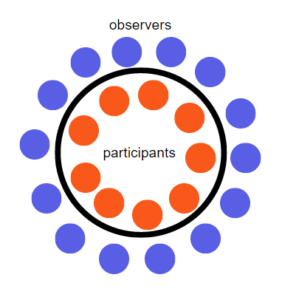 Description: This method involves one group observing another group. The first group forms a circle and either discusses an issue or topic, does a role play, or performs a brief drama. The second group forms a circle around the inner group. Depending on the inner group’s task and the context of your course, the outer group can look for themes, patterns, soundness of argument, etc., in the inner group’s discussion, analyze the inner group’s functioning as a group, or simply watch and comment on the role play. Debrief with both groups at the end in a plenary to capture their experiences. See Jaques (2000) for several variations on this technique.
Description: This method involves one group observing another group. The first group forms a circle and either discusses an issue or topic, does a role play, or performs a brief drama. The second group forms a circle around the inner group. Depending on the inner group’s task and the context of your course, the outer group can look for themes, patterns, soundness of argument, etc., in the inner group’s discussion, analyze the inner group’s functioning as a group, or simply watch and comment on the role play. Debrief with both groups at the end in a plenary to capture their experiences. See Jaques (2000) for several variations on this technique.
- Class Size: 10-50
- Time frame: 15 or more minutes
- Setting: moveable seating and a lot of space preferable; if necessary, have inner group stand/sit at front of lecture hall and the outer group sit in regular lecture hall seats
- Modality: Face-to-Face
Comments: Be aware that the outer group members can become bored if their task is not challenging enough. You could have groups switch places and roles to help with this. Also note that the inner group could feel inhibited by the observers; mitigate this concern by asking for volunteers to participate in the inner circle or by specifying that each student will have a chance to be both inner and outer group members. Although this method is easiest to implement in small classes, you could also expand it so that multiple “fishbowls” are occurring at once.
Group Work in the Classroom: Types of Small Groups. Centre for Teaching Excellence, University of Waterloo.